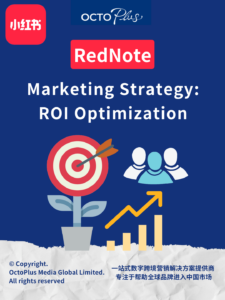2024 China B2B Marketing Trends and Insights White Paper
Discover the latest China B2B marketing trends 2024 and explore actionable strategies with OctoPlus Media.
Learn how to leverage AI technologies, optimize B2B content marketing, and adopt digital tools to overcome challenges and drive success in the evolving B2B landscape.
At OctoPlus Media, we specialize in helping businesses achieve success in the dynamic Chinese market. From leveraging AI-powered solutions to optimizing digital content strategies, our team brings years of experience and tailored approaches to deliver measurable results.
This article is based on the 2024 China B2B Marketing Trends and Insights White Paper, jointly published by Yuan Yu & Custouch. The report provides the latest industry insights and practical guidance for B2B marketers to navigate challenges such as budget constraints and technological transformation.
In recent years, China’s B2B market has been undergoing rapid changes. From economic fluctuations to technological advancements, B2B marketers are facing significant challenges and opportunities. This article highlights the key findings from the white paper, offering strategic guidance and actionable advice to help professionals thrive in a complex market environment.
1.0 Shifting Dynamics in China's B2B Marketing Data
1.1 Balancing Lead Generation and Revenue Goals
In the B2B sector, marketing teams are shifting their focus from merely acquiring leads to prioritizing lead quality and directly driving revenue. These changes in KPIs (Key Performance Indicators) reflect the growing pressure on marketers:
- 58% of companies prioritize lead volume as a core KPI.
- 43% focus on lead quality and audience growth (e.g., followers/subscribers).
- 38% now include revenue generation as part of their marketing team’s performance metrics.

(The Whitepaper is written in Chinese)
While traditionally, private enterprises were more likely to hold marketing teams accountable for direct revenue, many multinational corporations have also started adopting a revenue-focused approach, integrating “marketing-generated income” into their evaluation systems. This shift underscores the growing trend of aligning long-term strategies with outcome-driven goals, even in legacy corporate cultures.
1.2 Budget Constraints and Resource Limitations
Among surveyed companies, 61% of marketers cited insufficient marketing budgets as their biggest challenge in advancing initiatives, while 50% identified a shortage of marketing personnel as a key obstacle. Both figures have risen from 49% and 45% in 2023, indicating mounting pressure on resources this year.
Core Challenges:
- Budget Constraints (61%): Insufficient budgets have limited the ability to explore diverse activities and channels.
- Low Sales Team Alignment (51%): Inefficient collaboration with sales teams has impacted lead conversion and customer engagement.
- Staff Shortages (50%): Limited team sizes make it difficult to manage and produce content across multiple channels.
- Skill Gaps (46%): A lack of specialized skills has hindered the ability to innovate and differentiate marketing efforts.
- Lack of Executive Support (24%): Without clear backing from leadership, marketing teams struggle to secure resources and compete with departments like sales and operations for budget allocations.
1.3 Budget Cuts Becoming the Norm
In 2024, 46% of B2B marketers experienced varying degrees of budget reductions, yet their performance targets remained unchanged. This dual pressure has intensified the challenges of marketing operations and driven the need for optimized resource management and efficient investments.
A. Overall Budget Allocation
Survey results reveal that most B2B companies’ marketing budgets are concentrated in the mid-to-low range:
- 21% of companies allocate less than 1 million RMB.
- 21% allocate between 1 million and 3 million RMB.
- Only 4% allocate budgets between 8 million and 10 million RMB.
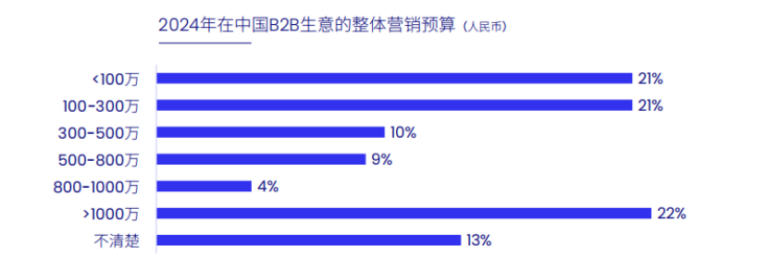
(The Whitepaper is written in Chinese)
This conservative budget distribution highlights that limited resources have become a common challenge across the industry.
B. Budget Trends
Compared to 2023, budget cuts have become more significant:
- 34% of companies reported stable budgets, reflecting a cautious approach.
- 23% reduced budgets by less than 20%, while 18% cut budgets by 20%-50%.
- Only 11% achieved slight budget increases, typically under 20%.

(The Whitepaper is written in Chinese)
The coexistence of reduced budgets and unadjusted performance targets has become an unavoidable reality for B2B marketers. In this environment, lean resource management and operational efficiency are crucial for success. The question of “how to achieve more with less” is one every marketer must answer.
1.4 Exploring New Industry Opportunities
Nearly 80% of marketers are tasked with improving performance despite shrinking budgets. With insufficient resources, the direct result is a decline in marketing effectiveness.
In 2024, the challenges facing B2B marketers are more pronounced than ever:
- Only 3% of respondents considered their marketing “highly effective,” a sharp drop from 13% in 2023.
- 41% rated their marketing as “effective,” remaining largely consistent with last year.
- 43% rated their efforts as “average,” indicating a need to rethink resource allocation and strategic planning.
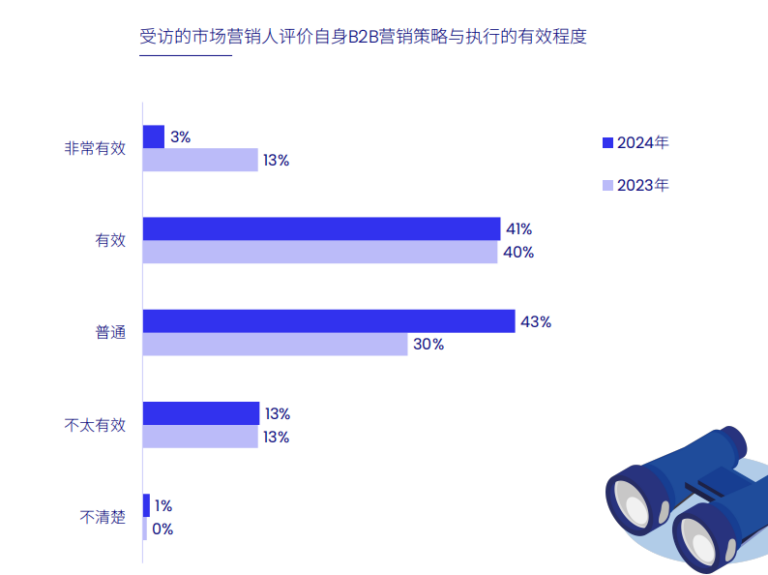
(The Whitepaper is written in Chinese)
While entering new industries is not without its challenges, identifying growth opportunities in emerging sectors will be a critical breakthrough for B2B companies as growth in traditional markets becomes constrained. By conducting in-depth research and implementing innovative strategies, businesses can secure a first-mover advantage in new blue ocean markets, driving overall growth.
1.5 Marketing Efficiency: Key Strategies and Data Insights
With limited marketing budgets, maximizing output has become a top priority for B2B marketers. Common approaches include re-purposing high-quality content for multi-channel distribution and leveraging technology to enhance efficiency. Notably, nearly 40% of marketers are using AIGC (Artificial Intelligence-Generated Content) to reduce content production costs and deploying SCRM systems to automate workflows.
Key Methods for Enhancing Marketing Efficiency
Based on survey data, marketers have adopted the following approaches:
- Multi-channel Content Distribution (76%): Publishing high-quality content across multiple platforms to maximize exposure.
- Content Re-purposing(63%): Optimizing resource allocation by reusing existing content in different formats.
- Marketing Automation (37%): Utilizing automation tools to accelerate customer conversions and streamline execution.
- AI-Assisted Content Creation (37%): Leveraging generative AI to reduce content production costs and increase speed.
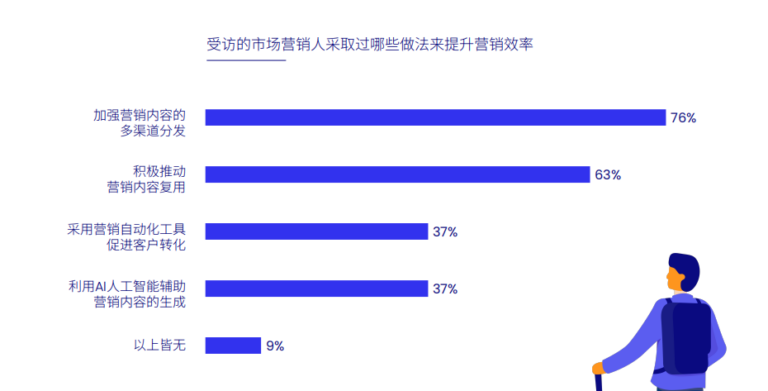
(The Whitepaper is written in Chinese)
2.0 Challenges in B2B Content Creation
Content creation in B2B marketing is a complex collaborative process requiring high coordination across multiple departments. Insufficient budgets often result in subpar quality for design and video content, leading to lower engagement and credibility. Companies face the following core challenges:
- Creating high-value content (53%): Producing unique and compelling content remains a difficult task.
- Maintaining consistent output (45%): Sustaining regular content production requires significant team effort.
- Maximizing ROI (44%): Optimizing resource allocation under tight budgets is critical.
- Insufficient marketing budgets (35%): Limited resources severely impact marketing effectiveness.
- Measuring campaign success (35%): The lack of effective metrics hinders the evaluation of marketing activities.
- Sales team support (34%): Collaboration between sales and marketing departments still needs improvement.

(The Whitepaper is written in Chinese)
2.1 Diversification and Effectiveness of B2B Content Marketing
Survey data shows that in 2024, B2B companies use an average of 6.97 content marketing formats to engage with customers, up significantly from 5.4 in 2023. This growth reflects companies’ increasing exploration of diverse content strategies to meet varying marketing needs.
High-Frequency Content Formats and Effectiveness Ratings:
- Social media posts (93%): Widely adopted due to their ease of dissemination, making them a top choice for companies.
- Video content (75%): Its growing importance is supported by the accessibility of video production tools.
- Exhibition booths (73%): Common in offline events, though often constrained by budget limitations.
- Webinars/Live sessions (58%): Offering real-time interaction, live sessions achieved the highest effectiveness rating.
Low Adoption Content Formats
- White papers (27%): Despite their depth, white papers are challenging to produce.
- Infographics (13%): Adoption is low due to the lack of visual design resources.
Insights and Recommendations
- Diversification and Relevance: B2B companies should focus on efficient, flexible content formats like social media and video while aligning with customer needs.
- Resource Prioritization: High-performing formats such as live sessions and exhibition booths deserve greater resource allocation to maintain competitiveness.
- Data-Driven Optimization: Continuously evaluate the effectiveness of various formats and prioritize high-ROI channels.
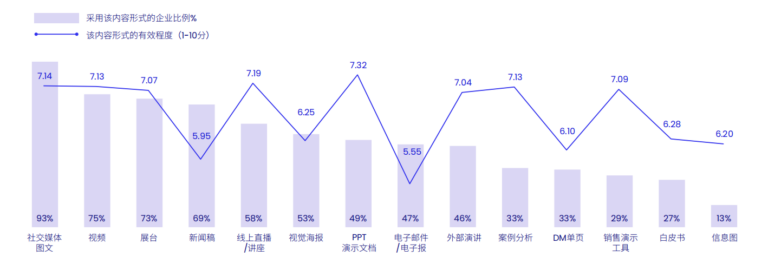
(The Whitepaper is written in Chinese)
2.2 Nearly 40% of B2B Companies Have a Clear Content Strategy
As content formats diversify, B2B companies are increasingly recognizing the importance of a well-defined content strategy. According to the data:
- 39%of companies have documented clear content strategies.
- 44%have an informal but relatively clear content direction.

(The Whitepaper is written in Chinese)
When it comes to content creation and output, surveyed companies are optimistic about the upcoming year:
- 52%plan to increase content output, showing strong confidence in content investments.
- 33%will maintain current levels, likely focusing on refining existing strategies.
Only 1% plan to reduce content output, reflecting a consensus on the importance of content in internal operations.

(The Whitepaper is written in Chinese)
2.3 Sales Teams: Obstacle or Collaborator?
Collaboration between marketing and sales teams is critical in B2B marketing. However, marketers often encounter two major challenges:
- Low content utilization: Despite the marketing team’s efforts, sales personnel often overlook well-crafted content, relying instead on pricing to persuade customers.
- Difficulty in obtaining customer stories: Gaining sales team cooperation to provide customer success stories remains a significant hurdle, limiting the availability of high-quality case studies.
Key Survey Insights for 2024
- 34%of marketers report a lack of support from sales teams as one of their biggest challenges.
- 51%observe low collaboration willingness from sales teams in promoting internal initiatives, a rise from 45% in 2023.
These statistics highlight a significant gap in collaboration between sales and marketing teams. Addressing this divide is critical for the success of B2B content strategies, as sales and marketing alignment directly impacts the effectiveness of content-driven campaigns.
3.0 Over 80% of Marketers Are Using AI: The Smart Transformation of B2B Marketing
In recent years, AI has evolved from skepticism to widespread adoption, becoming a critical tool for improving efficiency in B2B marketing. According to survey data, over 80% of marketers have integrated AI into their workflows, applying it to various tasks ranging from content creation to customer service.
3.1 Key AI-Supported Marketing Activities
- Content Translation (65%): AI-powered translation tools enable efficient multilingual content production, significantly shortening project timelines.
- Copywriting (63%): Generative AI technologies (e.g., ChatGPT) assist in creating content quickly, reducing creative costs.
- Image Generation and Design (33%): Generative AI enhances the production of visual assets, improving design efficiency.
- AI-Powered Customer Support/Chatbots (27%): Some companies use AI-driven chatbots to interact directly with customers, improving service speed and efficiency.
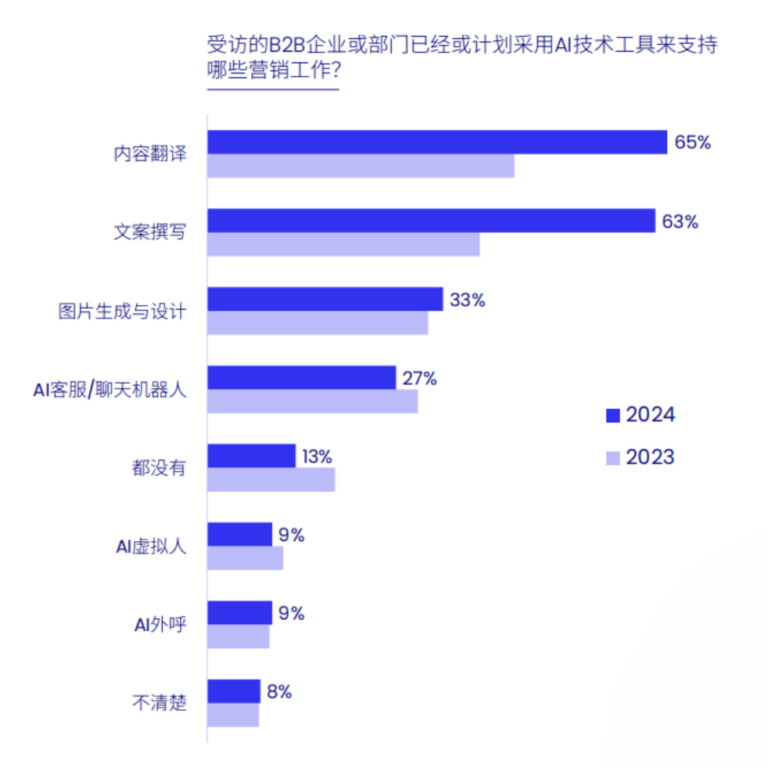
(The Whitepaper is written in Chinese)
Compared to 2023, the adoption rate of AI tools has increased significantly. Businesses are leveraging AI not only to boost productivity but also to achieve more precise and efficient marketing execution through its intelligent capabilities.
Remarkably, only 13% of surveyed companies have not adopted any AI technologies, indicating that AI is rapidly becoming a standard tool in the B2B marketing landscape.
4.0 Digital Marketing Tools
4.1 Online and Offline Budget Allocation
Data from 2024 highlights the continued growth of online marketing budgets, cementing its position as a critical investment area for businesses:
- 30% of companies allocate less budget to online marketing than offline marketing.
- 49% allocate more budget to online marketing than offline marketing.
Although offline activities remain indispensable in the B2B sector, the accelerating digital shift has made online marketing a priority for many businesses:
- Shifting resource allocation: Online channels offer flexible promotional opportunities, meeting budget constraints while addressing immediate tactical needs.
- Complementary value: Businesses increasingly recognize that online and offline activities are not substitutes but complementary elements in a holistic marketing strategy.
4.2 B2B Marketing Channels and Management Challenges
In 2024, B2B companies expanded their marketing channels, increasing the average number of channels by nearly two compared to 2023. This growth indicates that even under budget constraints, businesses actively explore and test new channels to better engage target audiences.
Most-Used Marketing Channels and Effectiveness Ratings:
- WeChat Official Accounts (98%): The most widely adopted tool for communication and customer engagement.
- Offline Exhibitions (78%): Despite digitalization, offline events remain irreplaceable in B2B marketing.
- Corporate Websites (77%): A foundational element for brand presence with consistent usage rates.
- WeChat Channels/Mini Programs (68%): Emerging as key platforms, particularly for engaging younger audiences.
- Offline Forums/Seminars (52%): The highest-rated channel in terms of effectiveness, enabling deep interaction in professional settings.
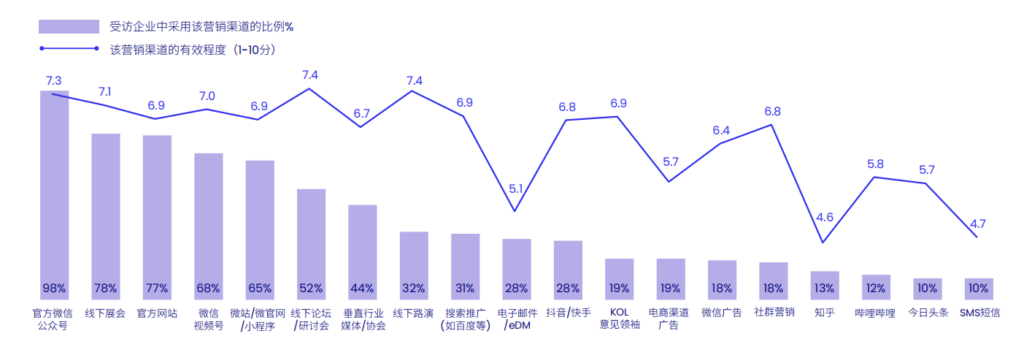
(The Whitepaper is written in Chinese)
4.3 Tackling Challenges in Marketing Channels
B2B companies face numerous challenges in managing and integrating customer data across channels. Key issues include:
- 48%: Data cannot be synchronized across official platforms (e.g., websites, WeChat).
- 43%: Lack of integration between marketing leads and CRM systems (e.g., Salesforce).
- 38%: Disconnection between public platforms (e.g., Douyin) and private platforms (e.g., WeChat).
- 34%: Inability to unify and analyze customer data collected across all channels.
- 19%: E-commerce platform customer data is not linked to private domain platforms.
These challenges hinder the coordination of marketing touchpoints, making it difficult to efficiently execute customer lifecycle management and precision marketing.
And the key issues raised:
- Incomplete customer profiles: Dispersed data across platforms prevents a comprehensive understanding of user needs.
- Wasted marketing resources: Data isolation leads to redundant efforts, increasing customer acquisition costs.
- Disjointed customer journeys: Marketing leads fail to transition seamlessly into sales systems, reducing conversion efficiency.
4.4 Building a CDP Fit for B2B Enterprises
As B2B marketing channels diversify, from traditional websites and WeChat to mini programs, short video platforms, and e-commerce ecosystems, managing data across different channels has become increasingly complex. To effectively integrate user behavior data, optimize customer journeys, and reduce resource waste, businesses need a systemized tool like a CDP (Customer Data Platform).
Core Functions of a CDP
- Cross-Channel Integration: Understand the complete customer journey across platforms and achieve a 360° customer profile.
- Data-Driven Decision-Making: Analyze user interaction data to provide actionable insights for marketing activities.
- Personalized Marketing: Trigger automated strategies based on real-time user behavior to meet individual needs.
For B2B enterprises, CDPs are more than just data storage tools—they serve as the foundation for marketing automation and decision optimization, especially for businesses requiring complex customer management.
4.5 Three Key Criteria for Determining CDP Necessity
- Complexity of touchpoints and data sources: If your marketing touchpoints span public platforms (e.g., Douyin) and private domains (e.g., WeChat), generating large amounts of fragmented data, a CDP is essential.
- Cross-platform interaction mechanisms: A CDP must enable single identity recognition (e.g., phone number, email) to track users across platforms and prompt actions (e.g., Call to Action). Without interactive engagement, the CDP’s value will be limited.
- Clear customer journey planning: For both high-intent customers (e.g., inquiries) and low-intent customers (e.g., content downloads), distinct customer journey paths must be designed to maximize each interaction’s impact and unlock the full value of collected data.
By adopting a CDP, B2B companies can overcome data fragmentation, enhance ROI, and create seamless customer experiences that drive long-term success.
5.0 Embracing the Future of B2B Marketing
In 2024, B2B marketers face the dual pressures of shrinking budgets and rising performance targets. To navigate these challenges, they must not only adjust strategies but also enhance their professional and team capabilities. Most marketers demonstrate extensive practical experience and a commitment to continuous learning, leveraging online content, forums, and corporate training to bridge gaps in systematic knowledge.
Survey data reveals that over 50% of B2B marketers maintain a positive outlook on their career progression, showcasing adaptability and a willingness to grow:
- 32%: Confident in their professional expertise, believing their careers are on an upward trajectory with promising prospects.
- 24%: Aware of potential challenges in career development but eager to make progress through continuous effort.
- 28%: Satisfied with their current career status, actively adapting to organizational needs.

(The Whitepaper is written in Chinese)
While the majority of marketers are optimistic about the future, a smaller portion struggles with uncertainty regarding their roles and industry value:
- 9%: Uncertain about their professional value and positioning, lacking clear direction for the future.
- 2%: Intend to leave B2B marketing entirely, planning to transition to other professional fields.
The 2024 China B2B Marketing Trends and Insights White Paper highlights the challenges and opportunities faced by marketers in a rapidly evolving landscape. By adopting innovative strategies, leveraging technology, and focusing on collaboration, B2B professionals can navigate growth pressures and unlock new opportunities for success.
At OctoPlus Media, we understand the unique challenges and opportunities in China’s B2B marketing landscape. With years of expertise in B2B marketing strategies and a proven track record of success, our team provides tailored solutions to help you overcome obstacles and achieve your business objectives.
Interested in taking your B2B marketing efforts to the next level in China? Contact the OctoPlus Media team today and discover how we can help you unlock new opportunities and drive growth.
Feel free to talk to us
It’s a team with one single shared goal, which is our client’s success. Deliver results for your business now.




























